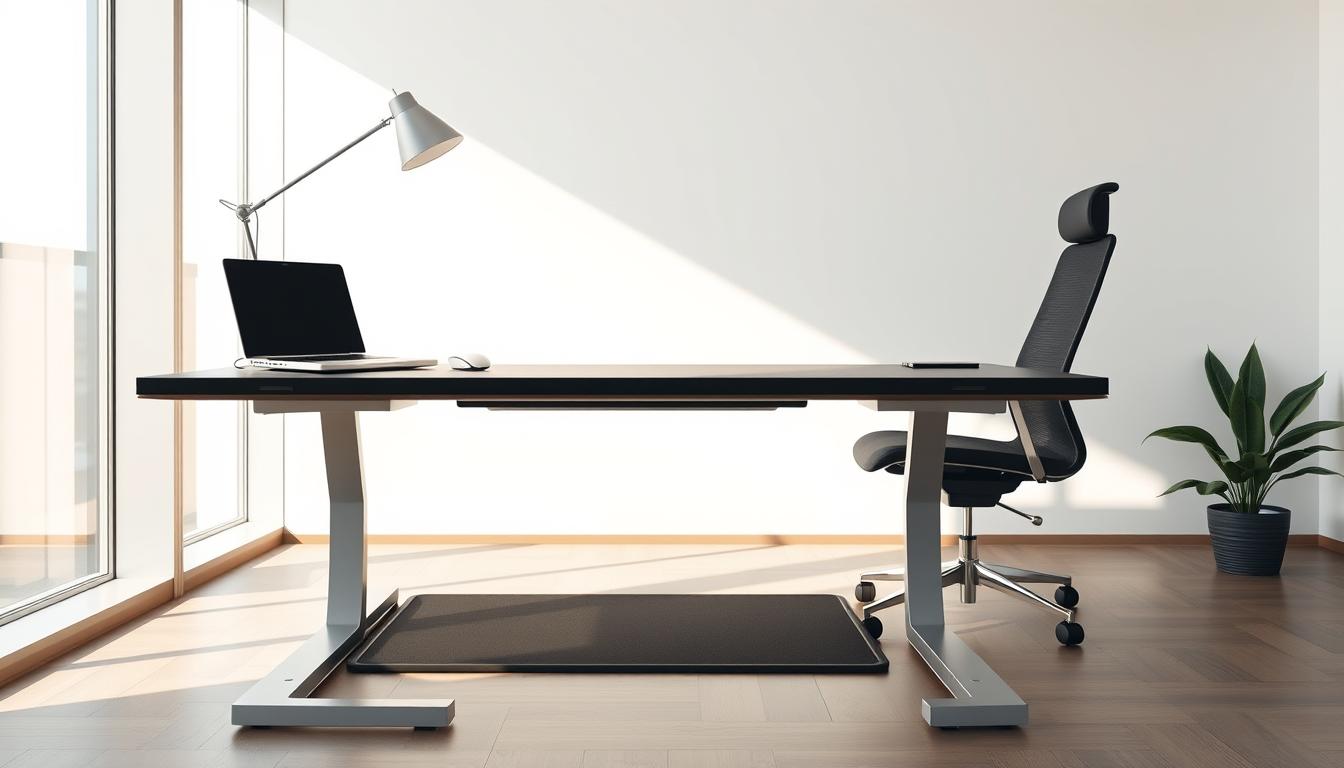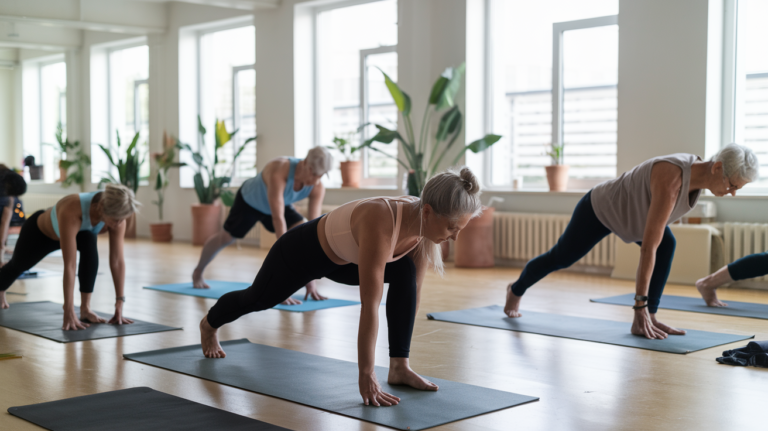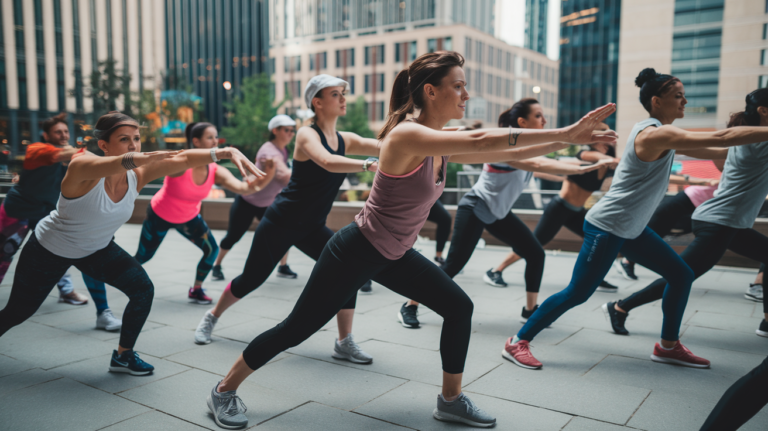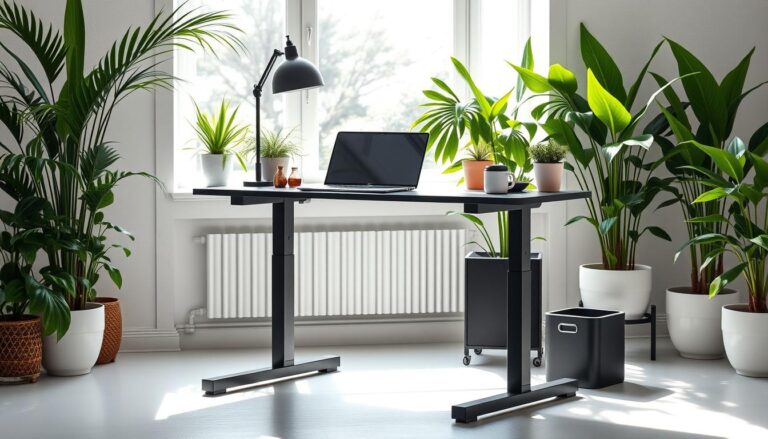Modern work routines often chain us to desks for hours, creating a tug-of-war between professional demands and physical wellbeing. Enter the walking pad – a slimline alternative to bulky treadmills that fits discreetly beneath standing desks. This clever piece of kit lets you maintain productivity while gently keeping your body in motion throughout the day.
This post contains affiliate links. If you purchase through these links, I may earn a small commission at no extra cost to you. Learn more here.
Unlike traditional exercise equipment, these compact devices focus on consistent, low-intensity movement rather than high-energy workouts. By converting idle standing time into calorie-burning activity, they help offset the health risks of prolonged sitting without demanding extra hours from your schedule.
Exercise physiologists champion this approach for its sustainable impact on metabolic health. We’ll explore practical strategies to integrate movement into your work routine effectively, backed by real-world success stories from those who’ve transformed their sedentary workdays.
Key Takeaways
- Compact walking pads offer discreet activity opportunities during desk work
- Low-intensity movement helps counterbalance prolonged sitting risks
- Energy expenditure accumulates through consistent daily use
- Adjustable speed settings cater to different task requirements
- Expert guidance ensures safe and effective implementation
Introduction to Walking Pad Desks
Today’s desk-bound professionals face an invisible adversary: the cumulative toll of stationary work postures. Research reveals sitting for long periods correlates with increased risks of cardiovascular strain, muscular atrophy and metabolic slowdown – what some experts now term ‘chair-borne illness’.
The Sedentary Work Challenge
Office environments often unintentionally encourage stillness. A typical worker spends over 6 hours daily rooted to their desk, a habit linked to 34% higher mortality risk according to recent NHS analysis. This isn’t about laziness – modern workflows simply prioritise cognitive output over physical engagement.
Enter adaptive solutions like standing desks and under-desk treadmills. These innovations allow gradual movement integration without disrupting productivity. A slimline treadmill operating at 1-2mph burns 100-200 calories hourly – enough to offset posture-related health concerns when used consistently.
The secret lies in sustainable motion. Unlike intense gym sessions requiring dedicated time slots, these devices facilitate gentle activity throughout the workday. Users report improved circulation and mental clarity within weeks, proving small movements yield compounding benefits.
What Is a Walking Pad Desk?
Contemporary office solutions increasingly address our need for gentle movement without disrupting workflow. A walking pad desk pairs a minimalist treadmill with workstation ergonomics, designed for sustained low-speed use rather than athletic training. Its slim construction tucks neatly beneath raised work surfaces, creating what physiotherapists call “active sitting” environments.
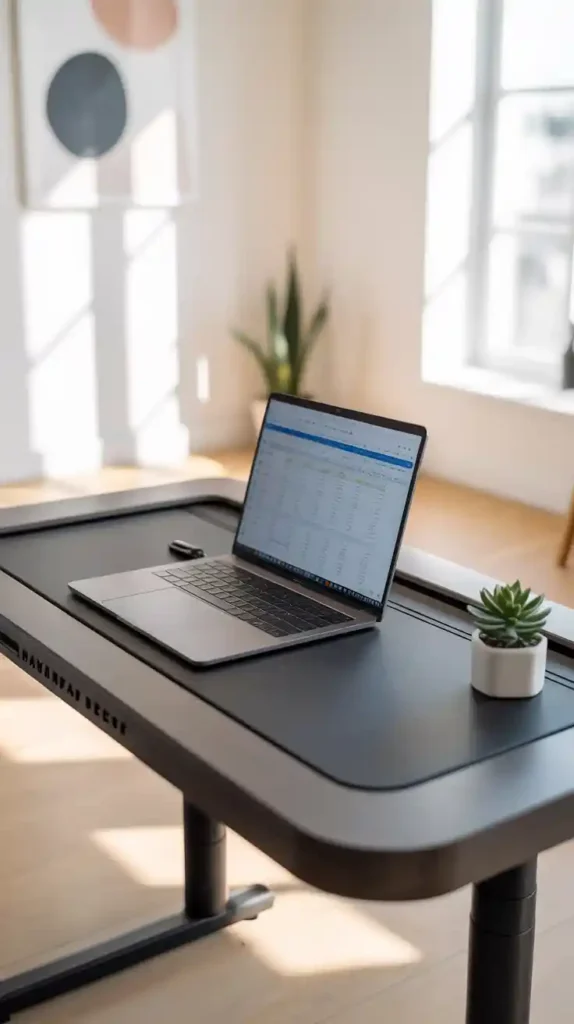
Design and Functionality
These devices eliminate bulky components found in standard treadmills. You’ll typically find lightweight frames, intuitive speed controls, and noise-dampened motors quieter than office printers. The absence of towering handrails allows natural arm positioning at your desk, while compact dimensions (often under 120cm long) suit most home office layouts.
Walking Pad vs Traditional Treadmills
Commercial gym equipment prioritises high-intensity workouts, whereas walking pads focus on accessibility. Traditional treadmills feature heavy-duty motors for sprinting, but their under-desk counterparts operate at 0.5-4mph – perfect for maintaining blood flow during video calls. Most models forgo incline settings to keep profiles sleek and user-friendly.
Integration requires careful desk setup. Position your screen at eye level and ensure keyboard placement allows relaxed shoulders. Many professionals alternate between 20-minute walking intervals and seated tasks, finding this rhythm sustains energy without distracting from work priorities.
Benefits of Using a Walking Pad Desk
The human body thrives on motion – a truth modern workspaces often neglect. Integrating gentle activity into desk routines sparks tangible improvements that ripple through both physical and mental wellbeing. Research confirms what early adopters report: small, consistent movements yield outsized rewards over time.
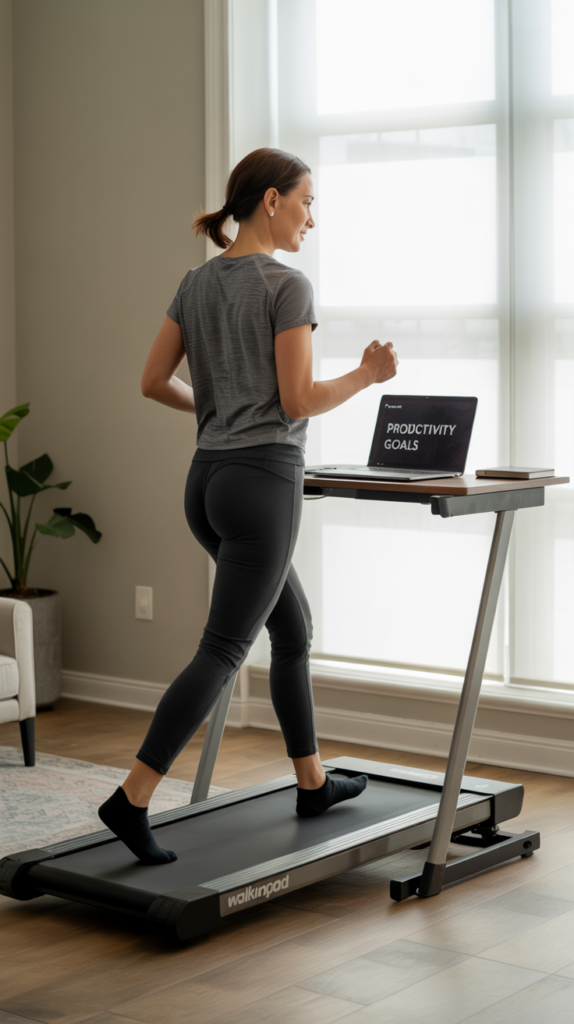
Physical Health Improvements
Regular use of an under-desk treadmill strengthens your body’s foundational systems. Exercise physiologists note enhanced blood circulation within weeks, reducing swelling in legs and feet common among desk workers. This steady motion also helps regulate blood sugar levels, lowering risks associated with prolonged sitting by up to 30% according to recent studies.
Calorie expenditure adds up surprisingly fast. A 60kg user walking at 2mph burns roughly 150 calories hourly – equivalent to cycling leisurely through the park. Over an eight-hour workday, this gentle activity could offset that morning croissant while maintaining focus on spreadsheets.
Mental Clarity and Productivity
The rhythm of slow-paced walking creates a cognitive sweet spot. Neuroscientists observe increased alpha brain waves during this state – the same patterns linked to creative breakthroughs. Users frequently describe ‘thinking walks’ where solutions emerge organically during video calls or data analysis.
Stress hormones like cortisol decrease with consistent movement, while mood-boosting endorphins rise. One London-based developer shared: “My afternoon energy slump vanished when I started pacing through tedious coding tasks. Now I tackle complex problems on my feet.”
This dual benefit – bodily nourishment paired with mental sharpness – makes under-desk walking more than a fitness trend. It’s a practical recalibration of how we approach sedentary work, prioritising sustained vitality over static efficiency.
How to Burn Calories While Working with a Walking Pad Desk
Transforming workstation inertia into calorie expenditure requires smart strategy rather than sweat. Research reveals even 1mph ambling burns 100-150 calories hourly – enough to counteract biscuit breaks without distracting from spreadsheets. The key lies in intentional pacing that complements cognitive tasks.

Effective Calorie-Burning Strategies
Start by matching speed to task complexity. Save 2-2.5mph sessions for routine emails, reserving slower paces (consistent movement patterns.
Incline settings amplify benefits subtly. A 3% gradient boosts calorie burn by 15% according to Loughborough University studies. Use this during lighter work phases – perhaps while reviewing documents – to elevate heart rate without compromising typing accuracy.
Consider micro-sessions scattered throughout the day. Ten minutes post-lunch counteracts blood sugar spikes, while brief post-meeting walks refresh perspective. These accumulated efforts often surpass single gym visits in total energy expenditure.
- Alternate speeds: 1mph for focused tasks, 2mph for lighter work
- Gradually increase daily movement time by 15% weekly
- Use incline features 2-3 times daily for 10-minute intervals
- Track progress via smart devices – aim for 5,000+ steps during desk hours
Remember, sustainability trumps intensity. A 60kg individual walking 3 hours daily at 1.5mph burns nearly 500 calories – equivalent to cycling 15 miles. Over weeks, this gentle approach yields results without demanding Herculean effort.
Equipment and Setup for Your Walking Pad Desk
Crafting an active workspace begins with smart equipment choices and spatial planning. The right combination of tools transforms any room into a movement-friendly environment, whether you’re in a spacious study or a cosy corner flat.
Choosing the Right Equipment
Selecting a treadmill for desk use involves balancing performance with practicality. Prioritise models under 10cm height for seamless integration with adjustable standing desks. Key features to consider:
- Weight capacity matching your build
- Whisper-quiet motors below 50dB
- Speed range accommodating 0.5-2.5mph
Many professionals opt for foldable designs when working from home. These space-saving units tuck behind doors or under beds, preserving living areas when not in use.
Home Office Setup and Integration
Ergonomics dictate successful implementation. Position your primary screen at eye level using wall mounts or monitor arms. This prevents neck strain during extended using treadmill sessions. Keyboard trays at elbow height maintain proper shoulder alignment while typing.
For compact spaces, vertical storage solutions prove invaluable. Floating shelves keep reference materials accessible without cluttering walking paths. Cable management systems prevent tripping hazards, ensuring safety during movement breaks.
Consider adding anti-fatigue mats if combining walking sessions with standing work. These cushioning surfaces reduce joint pressure, making sustained activity more comfortable over time.
Incorporating Walking Into Your Workday
The rhythm of modern employment often demands mental focus at the expense of physical engagement. Yet weaving movement into your schedule needn’t disrupt workflow – it can actually enhance it through strategic pauses that refresh both body and mind.
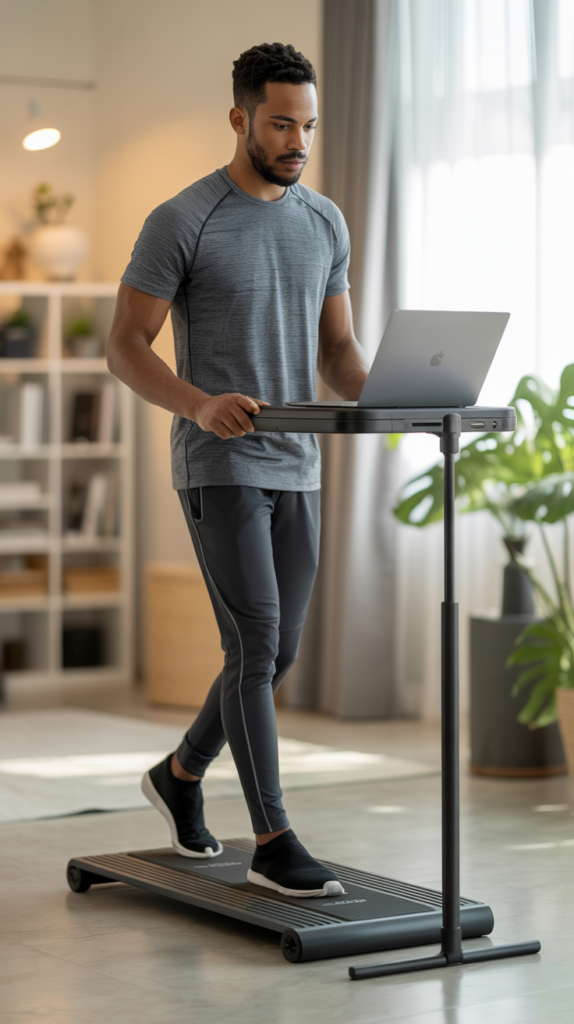
Scheduling Regular Movement Breaks
Think of movement intervals as cognitive pit stops. Setting reminders every 45-60 minutes prompts you to rise, stretch, or pace gently. These micro-breaks counteract stiffness while maintaining blood flow to your brain. Many find this pattern prevents afternoon slumps better than caffeine.
For those working from home, consistency proves crucial. Align walking sessions with natural transitions – after sending an email, between meetings, or during file uploads. Even five-minute strolls accumulate: eight brief intervals create 40 minutes of activity without carving extra time from your day.
Tracking steps adds motivational clarity. Aim to convert previously sedentary hours into productive motion. A modest goal of 50 steps hourly quickly surpasses 400 steps in an eight-hour period – nearly a fifth of daily recommendations achieved through work itself.
- Sync movement with calendar alerts or app notifications
- Use waiting periods (printing, loading screens) for quick walks
- Pair walking with listening tasks like conference calls
- Celebrate small victories – 100 extra steps daily builds habits
This approach helps get your energy flowing without overwhelming your schedule. The key lies in viewing movement as part of your work process rather than an interruption to it. Over weeks, these intentional pauses become second nature – a sustainable way to nurture wellbeing while maintaining professional output.
Optimising Speed and Incline for Calorie Burning
Mastering the balance between gentle movement and work focus begins with smart speed selection. The sweet spot lies where your pace feels sustainable yet engages muscles – typically between 1.2-1.8mph for most users. This range maintains productivity while activating calorie-burning mechanisms.
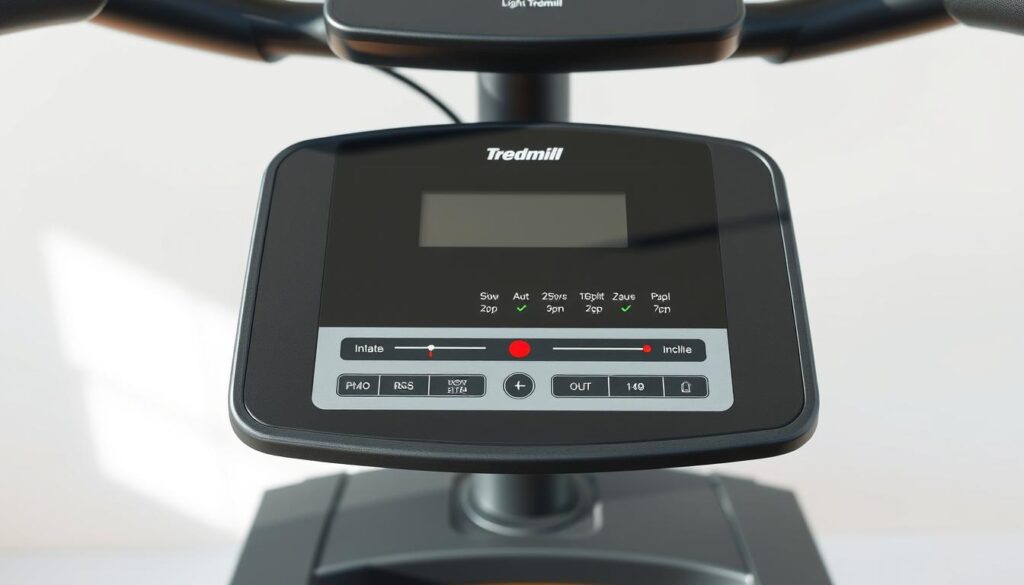
Finding Your Ideal Pace
Start by testing speeds during different tasks. Many find 1.5mph ideal for typing-intensive work, while creative thinking flows better at 1mph. Use these practical benchmarks:
- 1-1.4mph: Suitable for complex analysis or video calls
- 1.5-1.8mph: Effective for routine emails or data entry
- 2mph+: Reserve for short bursts during breaks
A recent treadmill calorie calculator study showed 70kg users burn 165 calories hourly at 1.6mph – equivalent to a brisk park stroll.
Using Incline to Boost Calorie Burn
Elevating your treadmill’s gradient by 3-5% can increase energy expenditure by 15-20% without raising speed. This approach maintains typing accuracy while engaging more muscle groups. Try this progression:
- Week 1: 1% incline for 20 minutes daily
- Week 2: 3% incline during lighter tasks
- Week 3: Alternate 5% intervals every 15 minutes
Track your walking minutes using smart devices. Aim to accumulate 90-120 minutes of movement across your working day – small increments that collectively make significant metabolic impacts.
Health Considerations and Safety Tips
Balancing movement with workplace safety demands thoughtful preparation. While integrating activity into your routine, prioritising physical health ensures long-term benefits outweigh any risks. Experts from sports medicine clinics highlight simple yet crucial measures that protect both body and productivity.
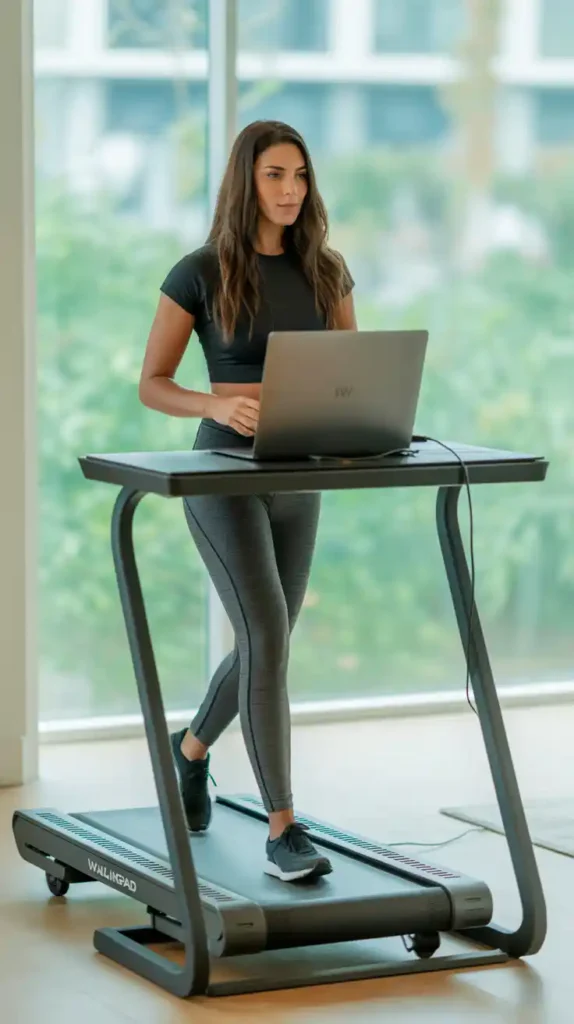
Foot Support and Body Alignment
Your choice of footwear significantly impacts comfort during treadmill sessions. Opt for trainers with arch support and shock absorption – flimsy slippers or bare feet invite foot fatigue. Podiatrists recommend replacing shoes every 500 miles, even for low-impact walking.
Posture adjustments prevent nagging aches. Keep screens at eye level to avoid neck strain, and position keyboards so elbows form 90-degree angles. If typing feels awkward initially, reduce speed to 1mph until muscle memory develops.
Beginners should make sure to build endurance gradually. Start with 20-minute sessions, adding five minutes every three days. This approach helps joints adapt without overexertion, particularly if you’ve been sedentary for long periods.
- Inspect treadmill belts monthly for wear
- Perform calf stretches before afternoon sessions
- Use desk fans to prevent overheating
- Schedule posture checks every 90 minutes
Lastly, make sure your equipment sits on non-slip surfaces. A wobbling treadmill during video calls isn’t just distracting – it risks muscle pulls. Many users find yoga sessions complement their walking routine by improving balance and flexibility.
Real-Life Experiences and Practical Advice
Adopting new work habits often feels like learning to dance while reciting poetry – initially awkward, but rewarding with practice. Many users report needing 7-10 days to comfortably coordinate typing with treadmill working. Sarah, a Bristol-based accountant, shares: “My first week felt like walking on a ship’s deck during mild swells. Now, pacing at 1.2mph feels as natural as breathing.”
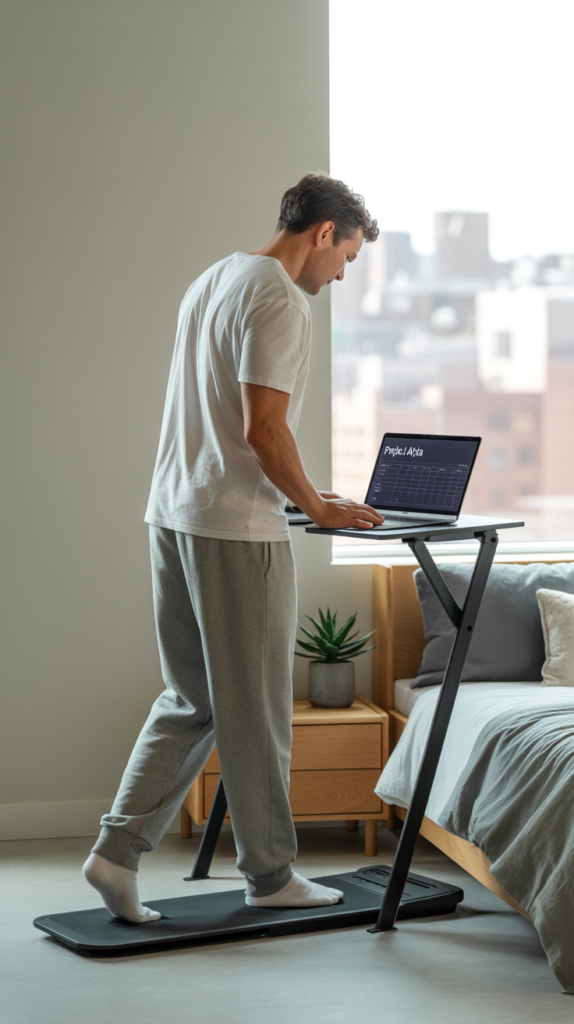
Overcoming the Learning Curve
Start with short sessions – 15 minutes hourly – to acclimatise. Pair your standing desk with the treadmill for stability during video calls. Early challenges like split concentration ease remarkably after day three, as your brain adapts to dual-tasking.
Practical adjustments make all the difference. Keep a water bottle nearby to avoid dehydration, and use voice-to-text software during faster walking intervals. Studies show most users achieve fluid coordination within two weeks when practising consistently.
Building a Consistent Routine
Structure your day around movement blocks. Try 45-minute work sprints followed by 15-minute walking intervals. Those working from home find morning sessions boost alertness, while post-lunch strolls aid digestion.
- Anchor walking time to existing habits – check emails or listen to podcasts
- Track progress weekly using smartwatches or step counters
- Pair treadmills with anti-fatigue mats for extended comfort
Persistence helps you reap rewards beyond calorie burn. Regular users report fewer afternoon energy crashes and improved sleep quality after six weeks. As one Manchester developer noted: “It’s not about drastic changes – just showing up each day, one step at a time.”
Comparing Walking Pads with Traditional Options
Selecting the right movement companion for your workspace hinges on understanding subtle trade-offs. While traditional treadmills dominate gym spaces, walking pads carve their niche through thoughtful adaptation to modern work rhythms.
Pros and Cons of Each Setup
Standard treadmills excel for intense workouts, with heavy-duty frames supporting speeds beyond 10mph. Their broad consoles suit gym environments but overwhelm home offices. In contrast, walking pads prioritise discreet operation – their whisper-quiet motors (often 60% quieter) won’t disrupt video calls.
Space requirements differ markedly. A typical treadmill demands 2m² permanently, whereas foldable walking pads tuck under beds. One Bristol-based accountant notes: “I answer emails on my walking treadmill during lunch breaks, then store it vertically – impossible with my old gym equipment.”
Cost considerations reveal another layer. Premium treadmills with incline settings often cost £1,500+, while basic walking pads start at £300. However, commercial-grade models lack under-desk compatibility – you’ll sacrifice work functionality for athletic features.
- Walking pad advantages: Space-efficient, work-friendly speeds, lower noise
- Traditional treadmill strengths: High-intensity training, advanced metrics
For those managing calls throughout the day, walking pads prove less intrusive. Their slim profiles allow natural arm positioning at your desk, unlike bulkier alternatives. Yet traditional models still reign for dedicated exercise sessions after hours.
Ultimately, your choice depends on whether movement should complement work or exist separately. Those seeking all-day activity integration find walking pads transform sedentary habits without demanding extra gym time.
Conclusion
Reimagining your workspace as a hub for gentle activity reshapes both health and productivity. By pairing thoughtful movement with desk-based tasks, you’ll discover it’s possible to offset extra calories without compromising work quality. The cumulative effect of low-intensity pacing – particularly when started first thing – builds metabolic resilience while keeping mental clarity sharp.
An efficient desk setup forms the foundation. Prioritise ergonomic alignment and noise-reduced equipment to sustain comfort during longer sessions. Those alternating between standing and subtle motion report better posture and energy management throughout the day compared to static positions.
Consider starting with morning walks during lighter tasks, gradually extending sessions as coordination improves. This approach helps get extra movement seamlessly into routines rather than treating it as an added chore. Many find midday pacing equally effective for combating post-lunch sluggishness.
Ultimately, integrating these strategies offers a practical way to nurture wellbeing within demanding schedules. As research and real-world experiences confirm, small steps at your desk can lead to strides in overall vitality – proof that modern work life needn’t be sedentary.

